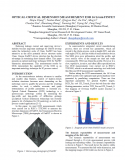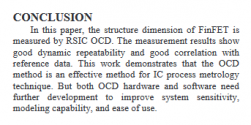That Technology can easily be returned to the sender...For large machines like tanks, yes, the power the AI would consume would be an insignificant fraction of the total power. However, I wasn't thinking large. Far cheaper than tanks would be swarms of tiny autonomous drones, each carrying flechettes loaded with neurotoxin. If you released a hundred thousand of them, they would totally destroy any human infantry. Now imagine releasing them inside a city: urban warfare would be almost easy.
Of course, such drones would need AIs more advanced than anything any country currently has, to operate in complex, real-world environments -- and to distinguish friend from foe. The AI would consume a significant fraction of such a drone's total power.
For example, consider a drone the size of a , which for many people is the state of the art today for small drones, or close to it. It's nowhere near autonomous, but let's ignore this. The drone's battery capacity is 3.8 Ah, it runs at 11.4 volts, and it flies for 27 minutes max. Thus it consumes 96 watts while flying. Now even a monster CPU like an Intel Core i9 10900K would be barely enough to run the simplest, most primitive AI -- and yet this monster will consume 250 watts TDP, several times the Mavic's total power. This is not "insignificant".
Thus even EUV lithography may not be enough, though breakthroughs in AI could happen to reduce the necessary computation load. If these breakthroughs don't happen, my hopes are on the neuromorphic chips, which are at least partly analog and therefore consume less power than fully digital devices. Analog circuits are less precise, but AI's neural nets are rather fuzzy anyway.
You are using an out of date browser. It may not display this or other websites correctly.
You should upgrade or use an alternative browser.
You should upgrade or use an alternative browser.
Chinese semiconductor industry
- Thread starter Hendrik_2000
- Start date
- Status
- Not open for further replies.
Is this in reference to SMIC? And all without EUV lithographic machines? Including the less than 7 nm nodes? Is this guy a MAGICIAN or what?View attachment 96428
From the above table my understanding is that N+1 went into production in Q3 2020, 7nm (aka N+2) in Q4 2021 and the follow up node (5nm?) is in production now (Q3 2022). It looks like the following node (3nm?) will have to wait till EUV is available in 2024/2025 and finally a GAAFET + EUV node ( I suppose this is 2nm) is scheduled for 2025.
It looks like Lingjie Xu is another super guy, just like Liang Mong Song of smic?
escobar
Brigadier
US. to restrict Nvidia from exporting its A100 and H100 server chips to China and Russia.
Ufff that maybe goods news for China AI Chips providers.US. to restrict Nvidia from exporting its A100 and H100 server chips to China and Russia.
A rare English-language news article on this topic that doesn't have a DPRK-level of anti-China hysteria:
“Ironically, while the U.S. has had a huge lead in EDA software, heavy export controls have caused China to invest heavily in coming to parity,” Hutcheson told EE Times. “Five years ago, China’s EDA offerings were essentially unusable. Today, they are very competitive, with limitations.”
Hutcheson said his EDA comments are based on private conversations with industry executives. China’s best, most visible EDA players are Hejian, Amedac, Aerdai, and X-Epic, he added.
He said he heard Chinese firms have reached “a level where they are very competitive at 28 nm and above and competitive down to 14 nm.
“Ironically, while the U.S. has had a huge lead in EDA software, heavy export controls have caused China to invest heavily in coming to parity,” Hutcheson told EE Times. “Five years ago, China’s EDA offerings were essentially unusable. Today, they are very competitive, with limitations.”
Hutcheson said his EDA comments are based on private conversations with industry executives. China’s best, most visible EDA players are Hejian, Amedac, Aerdai, and X-Epic, he added.
He said he heard Chinese firms have reached “a level where they are very competitive at 28 nm and above and competitive down to 14 nm.
Yeah, it looks almost too good to be true, so I'm cautious on that. It's basically saying the 7 nm process at SMIC is going to be equivalent to the 5 nm process at Samsung and TSMC. And that the N+1 process (I'm assuming this is the one tech insight looked at) is equivalent to 7 nm process at SMIC. Based on this roadmap, they have 7 nm and 5 nm equivalent process mapped out already and are going to be in mass production by this year (for N+1/7 nm equivalent) and next year (for the Samsung 5 nm equivalent) and maybe 2024 (for the Samsung 4 nm equivalent)Is this in reference to SMIC? And all without EUV lithographic machines? Including the less than 7 nm nodes? Is this guy a MAGICIAN or what?
This is the important part. It can be done with 7 nm process. Which means if they get sanctioned, they can be produced at SMIC fabs. This is probably where they should be transitioning things as SMIC and Hisilicon ramps up. They are going to need to buy as many ASML and SMEE DUVs as they can, lol
This is a pretty fast ramp for a GPU to come to market, obviously. Wen put together a chip design team with GPU experts from all over the world, and raised around $800 million through the beginning of this year to fund the research, development, and manufacturing of the chips, the latter of which is done not at SMIC, but across the South China Sea in Taiwan – specifically at Taiwan Semiconductor Manufacturing Co, the world’s most important foundry, and specifically using its mature 7 nanometer processes.
so let's see, the brainiacs at White House are restricting Nvidia just as the Chinese alternative becomes available? Am I missing something? Are they looking to help Biren and Baidu?US. to restrict Nvidia from exporting its A100 and H100 server chips to China and Russia.
Probably more than anything, now that natsec people have forced through these broad export restrictions on generic chips, any buyers of advanced chips in China will be looking for domestic alternatives.
The nextplatform.com article is quite interesting. Pay attention to how the company was started and the founders and their key tech people. They are either serial entrepreneurs or very senior tech people at major tech companies in the US (Nvidia, AMD) and/or China (HiSilicon, Alibaba) plus others (Samsung). With their experience and track records, they can quickly attract talents and fundings ($800 million).
It's hardly unique. We know there have been a couple of EDA companies started in the last couple years in China, with very similar experiences & profiles to the Biren people, albeit in a different segment. It's ironic that major EDA companies like Synopsis even invested in these new EDA companies, some of key people at these new startups were originally from them.
Also, many of the Chinese semiconductor equipment companies are founded by people with significant experiences at the major international semiconductor equipment companies. That's pretty well-known.
US. to restrict Nvidia from exporting its A100 and H100 server chips to China and Russia.
A rare English-language news article on this topic that doesn't have a DPRK-level of anti-China hysteria:
“Ironically, while the U.S. has had a huge lead in EDA software, heavy export controls have caused China to invest heavily in coming to parity,” Hutcheson told EE Times. “Five years ago, China’s EDA offerings were essentially unusable. Today, they are very competitive, with limitations.”
Hutcheson said his EDA comments are based on private conversations with industry executives. China’s best, most visible EDA players are Hejian, Amedac, Aerdai, and X-Epic, he added.
He said he heard Chinese firms have reached “a level where they are very competitive at 28 nm and above and competitive down to 14 nm.
What has happened is that the US sanctions on China in semiconductors over the last few years has suddenly created a very large market with fertile opportunities and accepting customers. If there weren't US sanctions, the prospects of these new startups (GPU, EDA, SEM etc.) would have been much dimmer, if they would still be founded at all. The semiconductor industry landscape was actually quite stable, mature and, some say, boring. The US-China tech war had changed all that.
It should be noted that in the semiconductor industry, including design, manufacturing, testing and assembly, as well as design software and equipment manufacturing, ethnic Chinese have a very large and prominent presence. These talents naturally feed into these potential opportunities. This is before we even consider the talent pools of East Asians. By the way, the same thing can be said of AI industry and community as well.
Therefore over the longer term, the prospect of the success of US sanctions on Chinese technology industries is rather pessimistic. In fact, even if we haven't got there yet, the US may have very well helped and accelerated the process of creating an alternative and competing tech industry centered around China.
- Status
- Not open for further replies.


